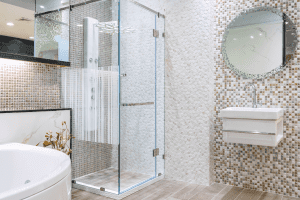Are you planning to have pocket doors installed in your home? If you haven't made up your mind yet if you're going to buy solid or hollow doors, you better read this. We've asked door experts for advice and here's what they have to say.
Pocket doors can either be solid or hollow core. Solid core doors are more durable and provide better insulation. They're best to use in your bedrooms and bathrooms. Hollow core doors are lightweight and easy to install. You can use them for your pantry and closet since these areas don't require completely shutting off the light, sound, and smell from other rooms.
Hang on because we're going to share more things with you about these doors that disappear behind the walls. We'll tell you if you can turn your regular door into a pocket door, how to use an existing door as a pocket door, and why some people don't like to use pocket doors in their homes.

Solid Vs. Hollow Core Pocket Doors
Pocket doors slide within a pocket in the wall when you open them, seemingly disappearing from view. They are the perfect door solution for those who don't have much space in a room since they don't require any clearance space for swinging.
Pocket doors are available in solid and hollow cores. However, the kind of door that you get would play a large part in determining how well a pocket door will perform its function. That's why it is important for you to understand the difference between the two.
Solid Core Doors
This type of door is filled with wood and its composites. Its interior is heavy and dense while its exterior is made of veneer. Because of its build, a solid core door is more durable. It also provides better insulation against heat and cold thus, making your room more energy efficient.
These doors are also more sound-proof. Since they are denser, they are able to absorb more noise, therefore, reducing the sound that reaches the room. This solves the common complaint against pocket doors that they do not block off noise from the outside.
Door experts recommend the use of solid doors because they are better able to hold onto the door hardware used for pocket doors.
The downside to solid core doors is that they are two to five times more expensive than their hollow counterpart. They are also heavier and more difficult to install because of their heavy built.
Hollow Core Doors
This type of door has a honeycomb interior that's made of cardboard. The exterior is made of fiberboard or veneer. It is lighter in weight and easier to install than solid doors. It is also less expensive that's why many homeowners are inclined to choose hollow core doors.
However, since it isn't compact and dense inside, it isn't very durable and not very effective when it comes to insulation and sound reduction. Door hardware also tends to be detached easily since they don't have a solid body to hold onto.
Which Pocket Door Type Is Right for You
Just to give you an idea, hollow core doors typically cost around $50 to $150. On the other hand, the average price for solid core doors is between $70 and $250.
Even though solid core doors are more expensive, they have better quality and offer more value for your money. That's why they are the better choice between the two doors.
However, it would also be a wise decision for homeowners to mix both kinds of doors in their interiors. There are rooms that need higher quality pocket doors such as the bedroom and bathroom.
Meanwhile, some don't require blocking off sound, smell, or light from their surroundings such as in the pantry or closet. This will help you save some bucks not just on the cost of the pocket door but the cost of labor as well since they're easier to install.
Can you turn a regular door into a pocket door?
You can use any type of door for your pocket door. But preferably, the door hasn't been pre-drilled with holes for the door handle and the hinges.
Of course, you have to make sure that your regular door fits the opening for your pocket door from the height, width, and thickness.
When the measurement is just right or if you're able to trim the door to size, you just need to drill and mortise your regular door so that you can install the needed pocket door hardware at the top and bottom of the door. Then hang the door on the slide. That's how you turn a regular door into a pocket door.
How do you use an existing door as a pocket door?
It is a good idea to reuse your old door and turn it into a pocket door. So here's how you do it:
- Measure the width, height, and depth of the door. Make sure that the door will fit in your pocket door opening. Most of the time you have to trim it to size. Take into account the door hardware that you'll attach on the top and bottom.
- Remove any existing door hardware on your old door.
- The holes left by the latch, deadbolt, and hinges can be filled with wood filler. You have to let them dry overnight to avoid cracks.
- You can leave the hole for the door handle untouched. It'll serve as your door pull to open and close the sliding door.
- Smoothen the edges of the door, filled holes, and hole for the door handle using sandpaper.
- If you want to paint the door, this is the time to do so.
- Install the pocket door hardware at the top and bottom of the door.
- Insert the door inside the tracks.
- Check the alignment of the door and see if it'll slide and lock properly.
That's it! You've just converted your regular door into a pocket door.
Why do people dislike pocket doors?
Just as pocket doors have their advantages, they also present some disadvantages to homeowners. Here are just some drawbacks to having pocket doors installed that make people dislike them.
Don't block off noise, smells, and light
Conventional doors can be locked in place and once closed, you cannot hear the sound from the outdoors, you won't be able to smell what's cooking from the kitchen, and the light from the adjacent room won't reach you.
Pockets doors are notorious for not being able to close properly. There's also usually a space under the door. As a result, they aren't as effective in blocking off the light, smell, and noise coming from outside of the room.
Noisy operation
Aside from not being able to stop outside noise from reaching you, pocket doors are also noisy to operate. No matter how carefully you try to open and close a pocket door, it will make a sound as it moves along its tracks.
Less stable and flexible walls
The pocket door walls shouldn't have any structural studs within them to allow the smooth passage of the door. There shouldn't be any plumbing, electrical wiring, or anything that can impede the movement of the pocket door as it opens and closes.
This makes these walls less sturdy since they don't have much support behind the exterior wall. They are also less flexible. They cannot bear the weight of cabinets and shelves. You can only hang or mount light materials on the walls so that they won't yield.
Functionality issues
Pocket doors are also known to fall off their tracks which can render them inoperable. Once there are issues with the tracks, you will find that it's hard to slide these doors. There can also be problems with alignment making them difficult to lock.
Accessibility issues
Pocket doors don't use traditional door handles and levers that are easy to grab onto when you open and close the door. Instead, they come with recessed or flush pulls. This makes it more challenging for people who have arthritis or have weaker hands to operate these doors.
Knowing the downside of installing pocket doors will help you in deciding whether this is the right door for you.

Final Thoughts
Pocket doors can either be solid or hollow core. It's just that experts recommend the use of solid doors since they are more durable, provide better insulation and noise reduction, and generally offer higher quality than hollow core doors.



